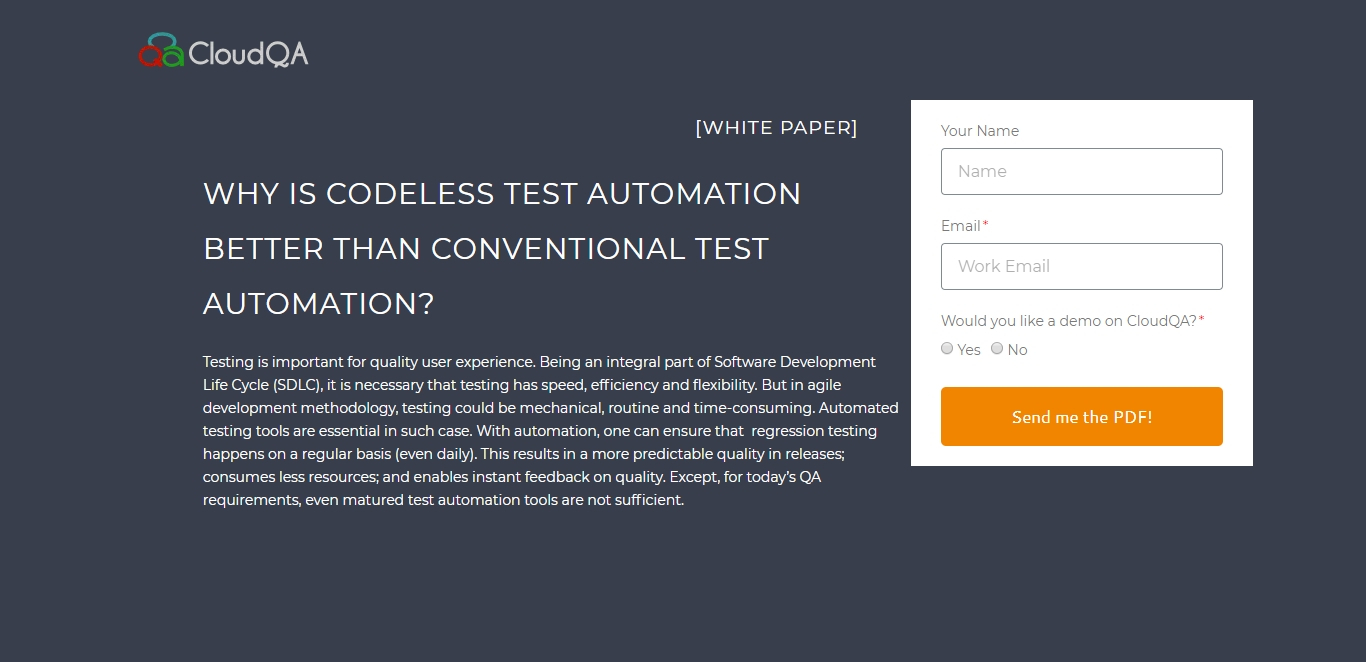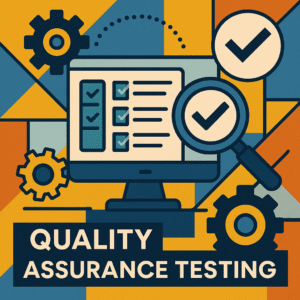CODELESS TESTING
Codeless Testing: The Complete 2025 Guide for Modern QA Teams
Last Updated: December 23rd 2025
Quickly convert your end-to-end web testing process to run over 80% faster and with greater accuracy. Get more information on CloudQA’s codeless platform today.
Table of Contents
Introduction
Software teams today release faster than ever , weekly, daily, sometimes multiple times a day. But while engineering velocity has increased, traditional test automation hasn’t kept up. Script-based frameworks like Selenium and Appium require specialized skills, long maintenance cycles, and fragile scripts that constantly break with UI changes.
Codeless testing (also called scriptless testing or no-code test automation) solves this problem by allowing QA teams to build automated tests using visual workflows instead of code.
This guide is the master resource for understanding codeless testing. It links to deeper articles on tools, scriptless frameworks, SaaS testing, Salesforce/D365 use cases, and more , forming a complete topical cluster.
Related reading:
- Top 5 Codeless Testing Tools in 2025
- Scriptless Testing Explained
- How Codeless Testing Helps in SaaS Applications
What Is Codeless Testing?
Codeless testing is a method of test automation where test cases are created using visual, drag-and-drop interfaces instead of writing code. These platforms use underlying logic, recorders, AI, and reusable components to automate tests without requiring scripting knowledge.
In simple terms:
Codeless Testing = Automation Without Writing Test Scripts
This makes automated testing accessible to:
- QA analysts
- Manual testers
- Product managers
- Business users
- Teams with limited automation engineering bandwidth
How Codeless Testing Works
Although users don’t write code, a codeless platform internally uses automation engines, selectors, validations, and workflows. A modern tool performs:
1. Visual Test Creation
- Record user actions
- Drag-and-drop steps
- Prebuilt test blocks
- Data inputs
- Assertions
2. Smart Element Identification
Cloud-era tools use:
- AI-based locators
- Self-healing selectors
- Multi-attribute detection
- DOM scanning
This prevents tests from breaking due to small UI changes.
3. Reusability & Modularization
Users can:
- Save components
- Reuse workflows
- Create test suites
- Share steps across teams
4. Data-Driven Testing
Upload datasets for:
- Login variations
- Form submissions
- Negative tests
- Regression coverage
5. Cross-Browser Execution
Run tests on:
- Chrome
- Firefox
- Edge
- Safari
6. Scheduling & CI/CD Integration
Modern tools support:
- Jenkins
- GitHub Actions
- Azure DevOps
- Bamboo
- Slack/Email alerts
Quickly convert your end-to-end web testing process to run over 80% faster and accurate now.
Why Codeless Testing Is Growing Fast (2025 Trends)
Codeless testing adoption is being driven by several real-world pressures:
1. Shorter Release Cycles
Teams need automation that scales with agile and DevOps.
2. Lack of Automation Engineers
Codeless platforms reduce dependency on specialized testers.
3. Growing SaaS Complexity
Apps like Salesforce and Dynamics 365 change frequently.
4. Faster Test Creation
Record-and-playback + reusable blocks = 5–10x faster test development.
5. Lower Maintenance
Self-healing reduces script rot and broken locators.
Codeless Testing vs Scripted Testing
Both approaches have strengths. Here’s the clean comparison:
Aspect | Codeless Testing | Scripted Testing (Selenium/Appium) |
Skill Required | Low | High (code expertise) |
Test Creation Speed | Fast | Slow |
Maintenance | Low | High |
Flexibility | Moderate | Very High |
Cost | Lower (time saved) | Higher (engineers needed) |
Best Use Cases | Regression, UI tests, SaaS | Complex logic, custom frameworks |
Deep dive:
Scriptless Testing – Complete Breakdown
When Should You Use Codeless Testing?
Use codeless testing when:
- You need to automate quickly
- You want non-technical QA to own test creation
- Your app UI changes frequently
- Your regression suite is growing
- You have limited automation engineering bandwidth
- You run SaaS platforms (Salesforce, D365, NetSuite, ServiceNow, HubSpot)
Related:
How Codeless Testing Helps SaaS Apps Maintain High Quality
When Codeless Testing Is NOT Ideal
It may not be suitable for:
- Highly complex workflows driven by custom logic
- Deep backend/API automation (unless platform supports it)
- Test frameworks needing heavy code manipulation
- Edge-case scenarios needing code-level control
Hybrid testing (codeless + code) is becoming the default in mature teams.
Codeless Testing Use Cases
1. UI Regression Testing
Ensure buttons, fields, flows, and forms still work after updates.
2. Functional Testing
Validate main app features.
3. Cross-Browser Testing
Run the same test across browsers automatically.
4. Salesforce Testing
Works well for:
- Lightning UI
- Dynamic components
- Workflow changes
See:
Salesforce Test Automation – Selenium vs Other Tools
5. Dynamics 365 Automated Testing
Codeless tools handle:
- Security roles
- Entity updates
- Form logic
See:
Microsoft Dynamics 365 Codeless Automation
6. End-to-End Business Flow Testing
Simulate workflows across apps such as:
- CRM → Billing → ERP
- SaaS → Database → Reporting
Core Advantages of a Codeless Approach
By simplifying the process, codeless platforms built on Selenium deliver significant, tangible benefits.
1. Accelerated Test Automation:
The most immediate impact is a dramatic increase in speed. By removing the coding barrier, test creation time is reduced from days to hours, or even minutes. This means teams can achieve higher levels of automation coverage much faster, leading to quicker feedback loops and more confident releases.
2. Drastically Reduced Learning Curve:
CloudQA offers an exceptionally intuitive user environment. The platform is designed with the philosophy that if you know how to navigate a web browser, you’re already equipped to create powerful automated tests. This low-barrier entry point allows for rapid onboarding and immediate productivity for new team members.
3. Enhanced Team Collaboration:
Because test cases are represented as simple, visual flows, they are understandable to everyone. This encourages effective team collaboration, allowing business analysts, project managers, and developers to actively participate in the testing process. Business analysts can record tests for the features they design, ensuring requirements are met, while developers can quickly understand a bug report by reviewing a visual test run.
4. A Highly Flexible Testing Environment:
Built on top of the robust Selenium framework, CloudQA provides an additional layer of convenience and focus. This structure allows teams to handle a wide array of testing complexities with ease, from simple form validations to intricate end-to-end business processes, all within a managed and user-friendly platform.
Beyond the UI: Using Codeless Tests for Performance & Load Testing
One of the most powerful and often overlooked benefits of a modern codeless platform is the ability to reuse tests for multiple purposes. At CloudQA, we’ve expanded the horizons of codeless testing beyond standard User Interface (UI) validation.
Traditionally, UI, performance, and load testing were three separate disciplines requiring different tools and skillsets. A functional test would verify a login works, while a performance test would measure how fast it works under load. With an advanced platform like CloudQA, these are no longer separate efforts.
The ability to reuse a single functional test for multiple scenarios is a game-changer. A test flow recorded once to validate a critical e-commerce checkout process can be repurposed with a few clicks to:
- Run as a UI Test: To ensure functionality is correct on different browsers.
- Run as a Performance Check: To monitor the speed and responsiveness of the checkout process with every new build.
- Run as a Load Test: To simulate hundreds or thousands of users attempting to check out simultaneously, identifying performance bottlenecks before they impact real customers.
This offers unparalleled efficiency and provides comprehensive quality coverage from a single, easy-to-maintain test asset.
A Buyer’s Guide: Choosing the Right Codeless Selenium Platform
When evaluating codeless tools, it’s essential to look for key features that ensure both immediate success and long-term scalability.
- Intuitiveness and Ease of Use: Is the platform genuinely easy to use for non-coders? The user interface should be clean, and the recording process should be reliable and straightforward.
- Reliability and Maintenance: How does the tool handle changes in the application? Look for features like AI-powered self-healing or smart object locators that reduce test flakiness and minimize maintenance.
- Reporting and Analytics: The tool should provide clear, actionable reports. Dashboards with historical data, video recordings of test runs, and detailed logs are crucial for quick debugging.
- CI/CD Integration: Ensure the platform offers seamless, out-of-the-box integrations with your existing CI/CD pipeline tools like Jenkins, GitLab, Azure DevOps, or GitHub Actions.
- Cross-Browser and Parallel Execution: The ability to easily run tests across multiple browsers simultaneously is fundamental to achieving speed and comprehensive coverage.
You can explore a deeper comparison here:
Top 5 Codeless Testing Tools in 2025 – Comparative Analysis
The CloudQA Difference: A Feature-Rich, Flexible Platform
CloudQA was built to relieve the primary pains associated with scripted test automation while harnessing the full power of Selenium. We aim to simplify your transition from manual to automated testing, catering to testers at all skill levels.
Our feature-rich SaaS platform offers:
- Self-healing scripts
- AI-based smart locators
- Advanced recorders
- Modular reusable components
- Cross-browser cloud execution
- Visual test builders
- Integrations with CI/CD
- Strong support for Salesforce & Dynamics 365 testing
CloudQA is positioned to minimize maintenance and maximize testing efficiency for agile teams.
Frequently Asked Questions (FAQs)
Q1: Is “codeless” a replacement for Selenium?
No, it’s an enhancement. Codeless platforms like CloudQA use Selenium as the underlying engine to interact with the browser. They provide a user-friendly abstraction layer on top, so you get the power of Selenium without the coding complexity.
Q2: Can we automate everything with a codeless tool?
You can automate the vast majority of web-based test cases. For extremely unique or complex scenarios, some platforms allow for small code injections, but the goal is to handle over 95% of test cases without any code at all.
Q3: How does the tool handle application changes?
This is a key differentiator for modern tools. CloudQA uses smart locators and AI-powered features to automatically handle many changes to the UI, significantly reducing the amount of time your team spends on test maintenance.
Q4: Do I still need developers or specialized QA engineers?
Codeless testing empowers your entire team, but specialists still play a vital role. Developers can focus on building features, while QA engineers can transition to more strategic roles like designing test architecture, managing the overall quality strategy, and tackling the most complex testing challenges, rather than just writing simple script.
Explore More in Our Codeless Testing Series

RECENT POSTS
Guides

How To Select a Regression Testing Automation Tool For Web Applications
Regression testing is an essential component in a web application development cycle. However, it’s often a time-consuming and tedious task in the QA process.

Switching from Manual to Automated QA Testing
Do you or your team currently test manually and trying to break into test automation? In this article, we outline how can small QA teams make transition from manual to codeless testing to full fledged automated testing.

Why you can’t ignore test planning in agile?
An agile development process seems too dynamic to have a test plan. Most organisations with agile, specially startups, don’t take the documented approach for testing. So, are they losing on something?

Challenges of testing Single Page Applications with Selenium
Single-page web applications are popular for their ability to improve the user experience. Except, test automation for Single-page apps can be difficult and time-consuming. We’ll discuss how you can have a steady quality control without burning time and effort.

Why is Codeless Test Automation better than Conventional Test Automation?
Testing is important for quality user experience. Being an integral part of Software Development Life Cycle (SDLC), it is necessary that testing has speed, efficiency and flexibility. But in agile development methodology, testing could be mechanical, routine and time-consuming.






